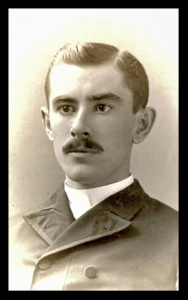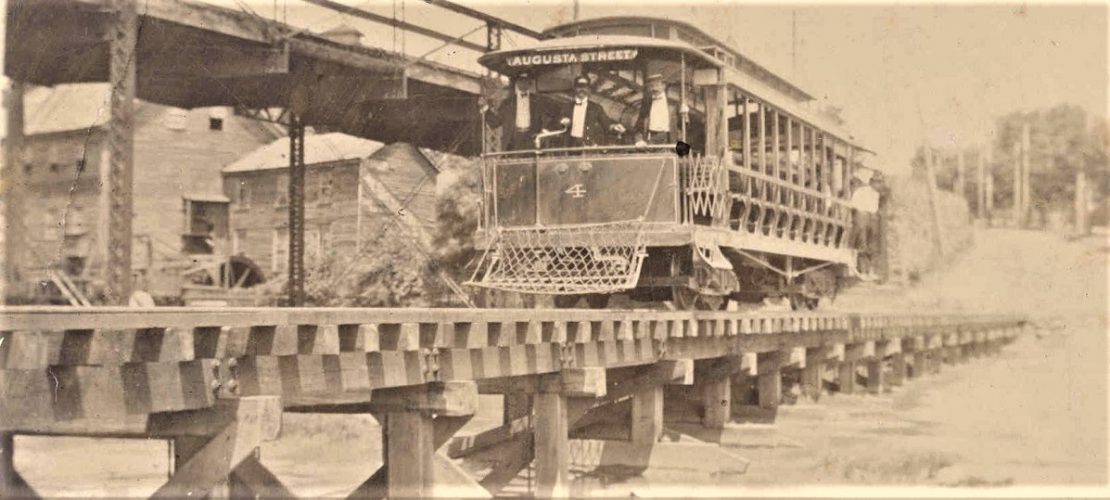 George Gregg was born to Robert Peterson and Caroline Chandler Mayes, September 18, 1866, in Mayesville, South Carolina. George’s father was one of nine children. The city of Mayesville is located sixty miles east of Columbia and was named for George’s grandfather, Matthew Peterson Mayes, Jr., whose property became a hub of activity when the rails were laid to provide train service to the area. During the twentieth century when the routes for President Eisenhower’s Interstate Highway System were laid out, cities lobbied hard to have a route come their way because it would provide increased traffic and greater opportunity for growth, but decades before there were highways for cars the railroads were essential for transit and economic progress. Just as Andrew H. Kerr worked tirelessly to bring the railroad to what became Kerrville in Tennessee, George Mayes’s grandfather brought the railroad and its benefits to the town named for himself.
George Gregg was born to Robert Peterson and Caroline Chandler Mayes, September 18, 1866, in Mayesville, South Carolina. George’s father was one of nine children. The city of Mayesville is located sixty miles east of Columbia and was named for George’s grandfather, Matthew Peterson Mayes, Jr., whose property became a hub of activity when the rails were laid to provide train service to the area. During the twentieth century when the routes for President Eisenhower’s Interstate Highway System were laid out, cities lobbied hard to have a route come their way because it would provide increased traffic and greater opportunity for growth, but decades before there were highways for cars the railroads were essential for transit and economic progress. Just as Andrew H. Kerr worked tirelessly to bring the railroad to what became Kerrville in Tennessee, George Mayes’s grandfather brought the railroad and its benefits to the town named for himself.
Mayes began college at Davidson in North Carolina but left the following year to continue studies and graduate with honors from the University of South Carolina in 1888. He prepared for pastoral work by taking a different theological education route than South Carolina candidates for the ministry usually followed—he moved to New Jersey to attend Princeton Theological Seminary. It is speculative, but his reason for heading to the Garden State could have been stimulated by a recent controversy at Columbia Theological Seminary regarding James Woodrow and his views concerning evolution and science which led to his removal from the seminary faculty. The decision of Mayes to study at Princeton could well have been motivated by doubts about the faculty of Columbia Seminary believing he would find Charles Hodge’s views expressed in What is Darwinism? agreeable as taught by his son, C. Wistar Hodge. What is more, Woodrow was teaching science at the University of South Carolina at the time Mayes was a student, so he could have been influenced firsthand to abandon studies at Columbia and journey instead to the north. David Calhoun commented.
Many—probably most, maybe all—Southern Presbyterians were dismayed by the long controversy. Columbia Seminary was damaged, First Presbyterian Church in Columbia was divided, and friendships were broken. (273)
William Plumer Jacobs took a hands-off approach deciding not to have anything to do with the Woodrow case because “grievous wrong” was “done on both sides.” Young Mayes may have been put off by the fighting and left the Presbyterian community in Columbia. Division in the church can be discouraging, especially for a young ministerial candidate. In 1891 he graduated with the Master of Divinity from Princeton Seminary while at the same time completing a Master of Arts a few blocks away at the university.
After licensure by Harmony Presbytery, he was ordained by South Carolina Presbytery, July 6, 1891, to serve his first pastoral call at Walhalla while also supplying the Bethel and Ebenezer Churches, with the Richland Church added in 1895. Richland Church is between Westminster and Seneca and should not be confused with Old Richland near Eastover in Richland County. It was common for ministers to supply small and sometimes isolated churches in conjunction with one or more formal calls because of a shortage of ministers. Mayes resigned the Walhalla call in 1897, then served a two-year call to the Edgefield Church which included supplying pulpits of recently started churches in Trenton, Johnston, and Ropers. What was the next step for George Mayes?
By 1899, Greenville was growing with the expansion of textile manufacturing that included among its entrepreneurs Ellison Adger Smyth, the son of Thomas Smyth, who had been the minister of Second Church, Charleston for a number of years. The Charleston church had played a part in Mayes’s education because it provided a stipend for his entire three years of study at Princeton Seminary and likely contributed to his decision to cross the Mason-Dixon Line to Princeton. It is curious that one with Mayes’s background would have needed a stipend, but then the Civil War had left many paupers who were prosperous before secession. Could the call to Second Church in Greenville have been encouraged by E. A. Smyth based on connections between the Mayes and Smyth families? Regardless of what the behind-the-scenes work may have been, elders J. C Bailey and R. E. Allen represented Second Church placing the call in Rev. Mayes’s hand at the presbytery meeting in Clemson. The call to Second extended from 1899-1904. The church was particularly grateful to Mayes for his work helping the congregation out of the great debt accumulated while building its current church building. Maybe his finesse with finances was why his next position was across River Street at Chicora College working as a financial agent. Mayes worked for Chicora briefly, because by the next year he was the pastor of Concord Church near Woodward continuing until 1909. He returned to Greenville until 1915 to work as chairman of the home missions committee for the Synod of South Carolina.
For twenty-five years Pastor Mayes experienced pastoral calls, supply assignments, and administrative work with his longest call extending six years, but his next call would be the last. Winnsboro, South Carolina is known in part for its historical involvement in the Revolutionary War and as was the case in Greenville, it was experiencing growth from the textile industry since construction of the Fairfield Cotton Mill in 1898. Winnsboro is the county seat of Fairfield County and when its courthouse was built the project was overseen by architect Robert Mills while he was commissioner of the Board of Public Works for the state. Mayes was installed December 31, 1915 to pastor both the Sion and Mt. Olivet congregations. A third congregation, Union Church, was added in 1922. He resigned from Sion in 1937 and the other two charges just before he retired in 1941 to remain in Winnsboro and enjoy his last years with his family.
Rev. George Gregg Mayes, D.D., died at his home early the morning of Friday, October 23, 1942. He was seventy-six years of age. Just two weeks before his death, he delivered the opening sermon at the meeting of the Synod of South Carolina held in Clinton. George and Alethea Cozby had married October 14, 1891, and she would pass away in 1951. Also surviving him were four daughters, one son, and nine grandchildren. George and Alethea are buried in the Sion Presbyterian Church Cemetery in Winnsboro where their marker is engraved with “Blessed are the dead which die in the Lord. They rest from their labors, and their works do follow them” adapted from Revelation 14:13. Mayes was honored by Presbyterian College in Clinton with the Doctor of Divinity in 1923 and he served on the college board for several years. For the dedication of Sion’s new church building in 1926, Mayes wrote Sion Presbyterian Church, Winnsboro, S.C., Historical Sketch, 1799-1926. He published a brief article in 1926, “The Synod and Home Missions,” in History of the Presbyterian Church in South Carolina Since 1850, 319-29. During his years of ministry as a churchman, he was the moderator of the Synod of South Carolina and the stated clerk of South Carolina Presbytery for five years followed by six years at the scribal desk for Congaree Presbytery.
Barry Waugh
Notes—The header shows the Augusta Street trolley in 1905 and is from the collection of the Greenville County Library System; Mayes may have ridden on this public conveyance that passed close to the Second Church property. For a chapter discussing the Woodrow case at Columbia see David B. Calhoun’s Our Southern Zion: Old Columbia Seminary (1828-1927), Banner of Truth, 2012, and regarding Princeton Seminary and Charles Hodge, see Bradley J. Gundlach, Process and Providence: The Evolution Question at Princeton, 1845-1929, Eerdmans, 2013. Sources include, F. D. Jones and W. H. Mills, History of the Presbyterian Church in South Carolina Since 1850, Columbia: Synod of South Carolina, 1926. Invaluable for the study of Presbyterianism in South Carolina is Joseph B. Martin, III’s, “Guide to Presbyterian Ecclesiastical Names and Places in South Carolina 1685-1985,” as published in South Carolina Historical Magazine, combined issue 90:1 &2, January-April, 1989; the numerous Presbyterian churches, educational institutions, and other entities are meticulously researched and help readers discern quandaries such as which of over a dozen Bethel Presbyterian Churches is the one relevant to one’s interest. The Greenville Mountaineer, Oct. 31, 1899, and Greenville Daily News, July 21, 1900, were consulted along with some clippings that have no newspaper names cited. Some information was used from Dr. Mayes obituary in the Winnsboro newspaper, The News and Herald, Thursday, Oct. 29, 1942. Information on the Enoree Presbytery meeting that processed Rev. Mayes’s call to Second Church is found in Ninetieth, Ninety-First, and Ninety-Second Sessions of the Presbytery of Enoree, Greenville, May 1, 1899, Clinton, June 8, 1899, Reidville, Sept. 12-14, 1899, Spartanburg, 1899, pages 10 and 15.





